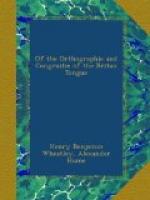2. Quherfoer in this case I wald co_m_mend to our men the imitation of the greek and latin, quho, to mend this crook, devysed diphthongs. Let the simplest of these four soundes, or that q_uhi_lk is now in use, stand with the voual, and supplie the rest with diphthonges; as, for exemple, I wald wryte the king’s hal with the voual a; a shour of hael, with ae; hail marie, with ai; and a heal head, as we cal it, quhilk the English cales a whole head, with ea. And so, besydes the voual, we have of this thre diphthonges, tuae with a befoer, ae and ai, and ane w_i_th the e befoer, ea. Ad to them au, howbeit of a distinct sound; as, knaulege with us, in the south knowlege.
3. These and al other diphthonges I wald counsel the teacheres not to name be the vouales quherof they are maed, but be the sound q_uhi_lk they maek, for learneres wil far maer easelie take the sound from the mouth of the teacher, then maek it them selves of the vouales ingredient.
4. Of e, we have tuae soundes, q_uhi_lk it is hard to judge q_uhi_lk is simplest; as, an el, ulna; and an el, anguilla; hel, infernus; and an hel, calx pedis. Heer I wald com_m_end to our men quhae confoundes these the imitation of the south, q_uhi_lk doth wel distinguish these soundes, wryting the el, ulna, with the voual e, and eel, anguilla, with the diphthong ee. I am not ignorant that sum symbolizes this sound w_i_th a diphthong made of ie; eie, oculus; hiel, fiel, miel, etc. Here I am indifferent, and onelie wishes that the ane be used; let the advysed judge make choise of q_uhi_lk, for my awne paert I lyke the last best; 1. becaus eie, oculus, can not wel be symbolized ee; 2. because the greekes expresse eta be +ee+, q_uhi_lk, as appeares be the Ioneanes and Doreanes, drawes neerar to alpha, than epsilon.
5. Of i, also, our idiom receaves tuae soundes, as in a man’s wil, and the wil of a fox. Heer, also, I wald have our men learne of the south, for these soundes they wel distinguish, wryting wil, fil, mil, stil, with i; and wyl, fyl, myl, styl, with y.
6. Heer I see be Barrat, in his Alvearie, that sum wald be at symbolizing these soundes, the ane with the greek diphthong +ei+, and the other with “i” inverted; as, r+ei+d, equitare; b+ei+d, manere; r"i"d, legere; h"i"d, cavere. In this opinion I se an eye of judgement, and therfoer wil not censure it, except I saw the auctour’s whole drift. Onelie for my awn parte I will avoid al novelties, and content my self with the letteres q_uhi_lk we have in use. And seeing we have no other use of y distinguished from i, condiscend to the opinion of the south using i for ane, and y for the other.
7. O, we sound al alyk. But of it we have sundrie diphthonges: oa, as to roar, a boar, a boat, a coat; oi, as coin, join, foil, soil; oo, as food, good, blood; ou, as house, mouse, &c. Thus, we com_m_onlie wryt mountan, fountan, q_uhi_lk it wer more etymological to wryt montan, fontan, according to the original.




